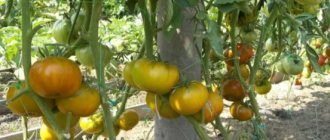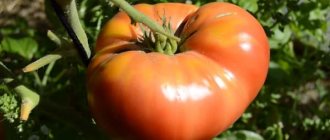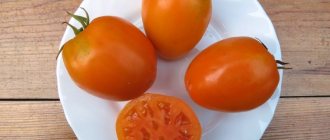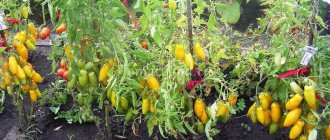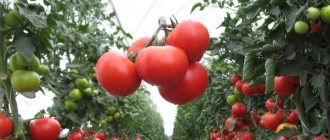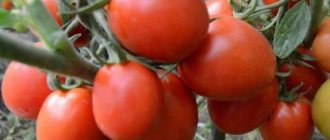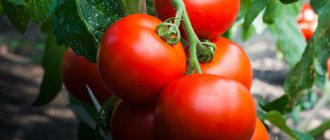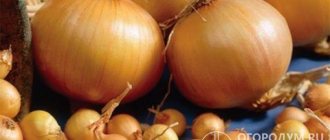| Ripening period: | early |
| Shape, weight of fruits: | flat-round |
| Bush type: | determinant |
| Growing regions: | all regions |
| Productivity: | up to 4.5 kg per bush |
The Big Mommy tomato, created by Gavrish, was accepted by the State Register in 2015 and recommended for cultivation throughout Russia. It is planted in open and protected ground, always obtaining a good harvest. Characteristics and descriptions, as well as positive reviews from gardeners, allow us to consider the Big Mommy tomato variety one of the best large-fruited tomato varieties created in recent years.
Description and characteristics of the variety
Big Momma tomatoes are early, ripen 85-95 days after the seeds hatch. The bush is determinate, low-growing, 65-70 cm high in open ground, about 1 meter in greenhouses.
The leaves are large, light green, medium dense, prone to boat curling. This must be taken into account when caring, and not immediately grab fungicides or fertilizers.
The fruits are smooth, large, even, multi-chambered, bright red in color. The shape in the State Register is declared as flat-round, but for some reason the manufacturer declares it as heart-shaped. In practice, as can be clearly seen in the photo and the video shot by the Gavrish company itself (the breeder), most tomatoes are only slightly flattened at the poles. In the general mass there are almost perfectly round ones.
The weight of tomatoes is from 220 to 340 g, the largest are located at the bottom, as they move up they become smaller slightly. There are 6-8 brushes, each with up to 8 tomatoes. Productivity per bush:
- in the garden they harvest up to 4.5 kg;
- in protected ground - about 7 kg.
The pulp is grainy when broken, with a high juice content. The taste and aroma are rich. The sweetness is harmoniously complemented by sourness. The fruits are eaten fresh and used for winter salads, pastas, and juices. Their size does not allow them to be preserved entirely.
Tomato Big Mom: care after transplanting into a greenhouse
Big Momma tomatoes: planting photos
At the time of transplanting, the Big Momma tomato seedlings have five to six leaves and grow about 25 centimeters. But before transplanting tomatoes, you need to carefully prepare the soil in the greenhouse.
Soil requirements. The earth needs to be dug up well. Many gardeners prefer to remove the top layer of soil 7-10 cm deep and fill this place with a nutritious mixture of turf soil and humus in equal proportions. To make the soil more loose, you can add sawdust mixed with ash (sawdust alone increases the acidity of the soil, and tomatoes do not like this). Then, for preventive purposes, the prepared soil should be spilled with a “Fitolavina” solution, which will help prevent the emergence and spread of various diseases. Holes for seedlings should be made every 40 cm in a row, and the distance between rows should be at least half a meter. You can purchase special soil for tomatoes at the farm store; you can add it to each hole when planting seedlings.
Planting dates and care features
Tomato seeds of the Big Mom variety are planted for seedlings from late March to early April, approximately 45 days before moving to a permanent place. They dive after the formation of 1-2 true leaves.
Tomatoes can be replanted:
- to the greenhouse - when the earth warms up to 10° C;
- on open beds - at 15° C.
The Big Mommy variety is recommended for vegetable gardens and film shelters. But no one is stopping you from planting it in a polycarbonate greenhouse.
To effectively use the usable area, you need to grow a tomato in 2 trunks. So fruiting will continue when all the flower clusters are formed on the main shoot and it is completed.
The planting pattern recommended by the manufacturer is 0.4x0.5 m.
Care is as follows:
- Gartering the bush immediately after planting in the ground will make it easier to care for. After the fruits are formed, there is no danger that overloaded shoots will fall on the ground.
- Regular moderate watering. If you alternate periods of drought with plenty of moisture, Big Momma's fruits will crack.
- Root feeding. First - with a predominance of nitrogen in order to increase sufficient green mass. After extending the second flower brush - phosphorus-potassium and calcium fertilizers.
- Foliar feeding is how plants better perceive and absorb microelements.
- Removing stepsons and leaves under the brush that has begun to fill.
- Preventive treatments against diseases, pest control.
- Loosening, weeding, mulching beds.
- In open ground, hilling will be required.
- Regular inspection of bushes to identify signs of disease or lack of nutrients, pests.
- Harvesting.
How to fertilize the Big Momma tomato?
Fertilizers. During the process of planting, fertilizers must be added to the hole, which, gradually dissolving, will nourish the bush and enrich the soil with potassium and phosphorus, which tomatoes need at each stage of growth. Place the fertilizer a few centimeters from the root of the seedling and fill the hole with soil. Such drugs as Fertika or Kemira are suitable.
Before the plants bloom, you can apply one or two nitrogen fertilizing. After flowering begins, nitrogen fertilizing should be stopped and from now on the emphasis should be on potash fertilizers. Foliar feeding with an ash solution is especially effective during this period, thanks to which tomato bushes easily and quickly absorb nutrients. To prepare, mix a glass of wood ash in a liter of hot water and leave for two days. Then the concentrate is diluted and the tomatoes are sprayed.
Peculiarities
One of the advantages of this variety is that it does not require special care. The big mother can be planted in the country, where the owners visit only on weekends. Even in open beds, tomatoes can withstand low temperatures or short-term drought.
Under unfavorable conditions and little care, the variety will still produce a harvest. True, the fruits will be smaller and not of such quality.
In their reviews, gardeners differ diametrically when describing the taste of Big Momma. Some admire it and point out the real tomato aroma, others compare it to grass.
It is likely that this particular variety is particularly sensitive to nutrient deficiencies during ripening. Moreover, the deficiency does not affect the size or beauty of the tomatoes, but affects the taste, making it grassy.
With excess nitrogen fertilizing, tomatoes become sour and loose. If you exclude an element from the “diet” it will become tasteless. In the second half of the growing season, it is recommended to give N in ammonium form and in very moderate doses, when sprayed on the leaf. This will be enough to improve the taste, but nitrates will not accumulate.
Growing seedlings
Tomatoes are grown only by seedlings. For sowing seedlings, both purchased and own seeds are used, the germination of which remains for 10 years.
Before sowing, seeds must be sorted, disinfected in a weak solution of potassium permanganate and germinated to determine their germination capacity.
The branded material has already undergone pre-sowing treatment. It can be sown in the ground immediately.
The substrate for seedlings is selected to be light, neutral, with good air and moisture permeability.
Purchased soil is ready for use. Your own, from the garden, needs to be disinfected with a solution of brilliant green (2 drops per 1 liter of water) or heated in the oven at a temperature of 120° for 40 minutes.
Seeds are sown in moistened soil to a depth of 1.5–2 cm, sprinkled with loose substrate on top, slightly compacted for better contact with the ground, sprayed with warm water and covered with glass or a transparent film to prevent the substrate from drying out.
Shoots appear on 4-5 days. The film is removed and the container is placed in a warm, bright place.
- Seedlings need long daylight hours: 10-12 hours. To do this, the sprouts are illuminated with phytolamps.
- The optimal temperature is 20-25°.
- Picking must be done when 2 true leaves appear.
- Fertilizing is carried out with potassium humate, Agricola or a weak solution of potassium permanganate.
It is better not to use nitrogen fertilizer so that the plants do not stretch out. It is more important at this stage to stimulate the development of the root system, i.e. apply phosphorus fertilizers.
Disease resistance
The manufacturer (Gavrish company) declares that the Big Mommy variety is resistant to the most common crop diseases, without providing details. Judging by the fact that gardeners, when discussing the advantages and disadvantages of tomatoes on forums, argue about its size and taste, and do not even mention diseases, this is true.
Preventative treatments need to be done. Despite the early fruiting, the variety does not have time to escape late blight - it is determinant, not super-determinant.
Errors during cultivation
Despite its resistance to diseases, tomato, although to a lesser extent, is susceptible to rot, viral and fungal diseases. Gardeners who neglect to prevent these misfortunes may lose part or all of their harvest.
It is necessary to maintain low humidity in the greenhouse, arrange regular ventilation, remove diseased plants, apply insecticides and phytoncides at the first signs of damage to the bushes.
The optimal humidity for tomato is in the range of 45-60%.
Advantages and disadvantages
Big Momma is not a “plastic”-tasting tomato, provided the minimum agricultural technology requirements are met. Gardeners who have grown insipid, “no” fruits should reconsider their care. And be guided by the requirements of culture, and not grow tomatoes in accordance with your own ideas about organic farming. Then the harvest will be large and the fruits will be tasty.
Advantages of the Big Momma variety:
- ease of care;
- the opportunity to grow tomatoes in a summer cottage visited once a week;
- resistance to adverse factors, including short-term drought and cold snap;
- productivity;
- large fruit;
- early ripeness;
- short stature;
- the tomatoes are beautiful, smooth, even;
- classic tomato taste and aroma;
- possibility of planting in open and protected ground;
- suitable for fresh salads, processing;
- disease resistance;
- increased lycopene content;
- good transportability;
- The variety ripens well in boxes.
Disadvantages of the Big Momma tomato:
- in the absence of care and infrequent watering, the yield and quality of the fruit will be worse;
- a lack of nutrients in the second half of the growing season will cause the tomatoes to taste grassy.
Watering mode for tomatoes Big Mom
Tomatoes intended for greenhouse cultivation usually like fairly warm water, about +20 degrees. This may be due to the fact that when the air temperature is less than +20 degrees, tomatoes slow down their growth, and watering with cold water is perceived by all plants as a decrease in the ambient temperature. It is enough to water once every seven days, always in the morning. Watering should be carried out at the root and ensure that the soil does not become waterlogged. A little more moisture will be required at the time of fruit formation. After the soil dries out a little, it needs to be loosened and a layer of mulch laid. It is extremely important not to forget to ventilate the greenhouse so that the air humidity does not increase too much, as this can affect the pollination process and deprive you of your harvest.
Stepsons. The branches growing from the axils of the main leaves are called stepsons; they must be cut off once every two weeks. For the correct formation of the bush, one or two lower stepsons must be left, and the rest must be removed one at a time (if you cut everything off at the same time, this can injure the plant and lead to its disease). And when the fruits set and begin to grow, you can gradually begin to pick off the main leaves.
Also, even at the time of planting, you need to take care of installing supports to which you will then tie the tomato bushes so that they do not break under the weight of the fruit.
Similar varieties
Among the tomatoes there are varieties similar to Big Momma, unpretentious, early, determinate, short varieties with large round fruits:
- Hospitable tomatoes. The bush in open ground reaches 80 cm. The fruits weigh an average of 400 g, are red, flat-round, sweet, juicy, and ripen early. Tolerates temperature fluctuations well. Shows high resistance to fusarium and cladosporiosis. Yields 4-5 kg per bush.
- Fat Jack. Size is about 60 cm, early tomatoes, up to 250 g, red, round, flattened at the poles. They are distinguished by high adaptability to adverse conditions, keeping quality, and good taste. Productivity per plant is 5-6 kg.
- Foreign exchange. Early, consistently fruiting under any conditions, about 80 cm tall. The tomatoes are red, weighing 200-300 g, dense, easily transportable, sweet. Productivity per bush is 4-5 kg.
- The Velvet season. Determinate, early ripening, grows up to 70 cm in open ground, resistant to unfavorable conditions. Tomatoes are round, up to 300 g, with dense, sugary pulp. Harvest – 3-4.5 kg.
- Juno. Ripens early, grows up to 80 cm. Red tomatoes are flat-round, tight, fleshy, easy to grow, up to 300 g each. Stress resistance is high. Rarely suffers from fusarium, blossom end rot, and verticillium. Recommended for large farms, where it produces 400 centners per hectare.
- Russian is delicious. Mid-early, up to 80 cm high. The tomatoes are fleshy, flat-round, red, with a strong tomato aroma and sweet pulp, weighing up to 300 g. Shown resistance to cladosporiosis and fusarium. From 3.7 to 4.5 kg are collected from the bush.
A new promising tomato variety, Big Mom, gives a good harvest in open beds and in film greenhouses. It is rightfully considered one of the best created in recent years, requires minimal maintenance, and is adapted to unstable weather conditions. Tomatoes ripen well indoors and are suitable for fresh consumption and processing into juice, paste, and sauce.
Reviews from gardeners who planted
Many gardeners like to experiment and test all the new products that appear on the seed market in their summer cottages. They willingly share the results obtained on the Internet, leaving reviews and comments on amateur forums.
Alexandra, Krasnoyarsk:
“Big Momma planted a tomato for the first time in 2022 in a greenhouse. The summer turned out to be so hot that almost all the tomatoes did not produce a harvest, with the exception of this new variety for me. In extreme conditions, the flowers and ovaries did not fall off, but the fruits grew large and sweet. I planted only 4 bushes to test and thanks to them I was not left completely without tomatoes in the season.”
Tatiana:
“I really liked the tomato, but the shape is not heart-shaped at all, but round. All other qualities are the same as indicated on the seed packaging.”
Elena, Novoaleksandrovsk:
“I took a risk and planted half of the greenhouse with a variety that was new to me. At first we were worried, but then everything turned out for the best: Big Momma ripened almost a week earlier than other precocious ones, and caring for her turned out to be easy.”
Smile!:
“I really liked Big Momma. It turned out to be very productive, the tomatoes grew up to 240 g, I thought they would taste like “store bought” ones, but my expectations were not met - the taste is really very pleasant.”
Mistral:
“I planted Big Mommy, I didn’t like it. The fruits are large, beautiful, the variety is quite productive, but the pulp, in my opinion, is very hard and tasteless. The seed chambers are sharply limited, so even when cut it is clear that the pulp is very dense and hard.”
Zina:
“I really liked the tomato: productive, tasty, beautiful. I only planted two bushes, I will definitely plant more next year. In mid-July we were already eating tomatoes in salads.”
Pauline:
“I didn’t really like the variety. The bushes are beautiful, neat, low, but still require garter. The taste did not seem too rich, and the flesh seemed firm.”
Alexandra:
“I like to experiment and every year I leave space on the plot to test 2…3 new varieties. Last year I grew Big Momma and I think that this tomato has more advantages than disadvantages. In my opinion, the fruits are well suited for drying and freezing.”
